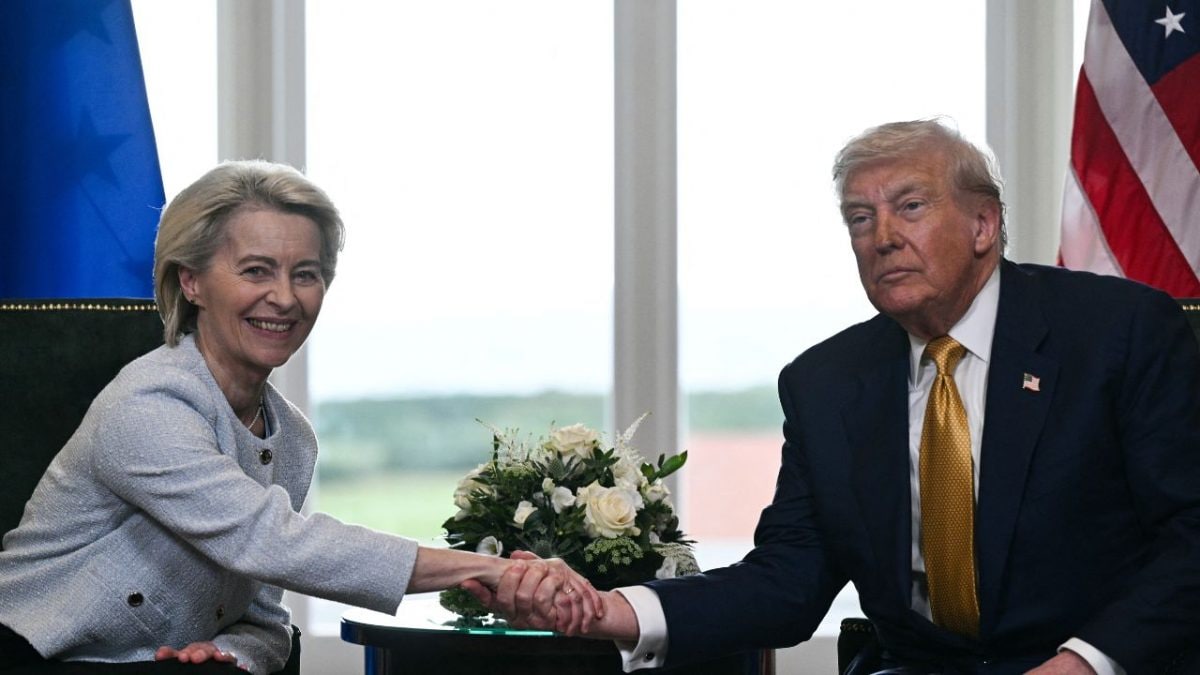The US-EU trade agreement sets a 15 per cent tariff on most EU goods entering the US, replacing a previously threatened 30 per cent rate. Here are the five key takeaways
read more
The United States and the European Union on Sunday (July 27)
struck a major trade agreement, averting a looming transatlantic trade war just days before an August 1 deadline.
Announced by President Donald Trump and European Commission President Ursula von der Leyen at Trump’s Turnberry golf resort in Scotland, the deal sets a 15 per cent tariff on most EU goods entering the US, replacing a previously threatened 30 per cent rate.
“It was a very interesting negotiation. I think it’s going to be great for both parties,” Trump said, while von der Leyen emphasised, “It will bring stability. It will bring predictability. That’s very important for our businesses on both sides of the Atlantic.”
Here are the five key takeaways from this landmark agreement.
EU to purchase $750 billion in US energy
A cornerstone of the deal is the EU’s commitment to buy $750 billion worth of US energy over three years, aligning with the bloc’s strategic shift away from Russian energy supplies.
Von der Leyen confirmed the EU will purchase $250 billion annually in liquified natural gas, oil, and nuclear fuels during Trump’s term.
This move supports the EU’s energy diversification goals, reducing reliance on Russia amid geopolitical tensions. Trump described the deal as “a good deal for everybody,” noting its potential to boost US energy exports while providing the EU with stable, non-Russian energy sources.
$600 billion EU investment in the US economy
The EU has pledged an additional $600 billion in investments into the US economy, though specifics on sectors and timelines remain unclear.
Trump claimed this would open “all of the European countries, which I think I could say were essentially closed,” despite the EU already importing over $400 billion in US goods annually, including pharmaceuticals, autos, and aircraft parts.
However, analysts caution that similar investment clauses in the US-Japan deal faced pushback, with Japanese officials denying claims that 90% of profits would remain in the US.
EU to procure “vast amounts” of US military equipment
In a significant shift, the EU agreed to purchase “a vast amount of military equipment” from US defence firms, moving away from its traditional focus on indigenous defence production.
Trump highlighted this as a key component of the deal, though no specific dollar amount was disclosed.
This commitment could benefit American defence companies, but it may spark debate within the EU, where leaders have prioritised building local defence capabilities.
General tariff reduced to 15%, averting trade war
The deal establishes a 15 per cent tariff on most EU goods entering the US, including automobiles, pharmaceuticals, and semiconductors, down from a threatened 30 per cent rate. This reduction averts a potential trade war that could have disrupted the $975 billion in goods exchanged between the US and EU in 2024, according to US Commerce Department data.
The 15 per cent rate, while higher than the pre-Trump average of 1.2 per cent, offers relief to EU exporters and US consumers facing higher prices for goods like French cosmetics and German cars. The agreement also includes zero tariffs on select goods, such as aircraft, plane parts, certain chemicals, generic drugs, and some agricultural products.
Steel and aluminium tariffs remain at 50%
Despite the broader tariff reduction, the Trump administration maintained a 50 per cent tariff on EU steel and aluminium imports.
Von der Leyen suggested further negotiations might address these rates, but Trump insisted, “Steel is staying the way it is. That’s a worldwide thing.”
This decision continues to challenge European steel exporters and could increase costs for US industries reliant on these materials.

